

Compact Muon Solenoid
LHC, CERN
| CMS-PAS-EXO-16-028 | ||
| Search for dark matter in association with a top quark pair at $\sqrt{s}= $ 13 TeV in the dilepton channel | ||
| CMS Collaboration | ||
| October 2016 | ||
| Abstract: A search is performed for dark matter production with top quark pairs decaying to dileptons in proton-proton collisions at centre of mass energy 13 TeV. Results are interpreted using simplified models for collider production of dark matter and constraints are placed on the parameter space. The data corresponds to an integrated luminosity of 2.2 fb$^{-1}$ collected by the CMS detector at the LHC in 2015. A combination is performed with previously reported analyses in the semileptonic and hadronic channels. | ||
| Links: CDS record (PDF) ; inSPIRE record ; CADI line (restricted) ; | ||
| Figures | |

png pdf |
Figure 1:
The dominant contribution to the $\mathrm{ t \bar{t} }$+DM process with a spin-0 mediator in the simplified model scheme. |

png pdf |
Figure 2:
Background-only post-fit $ {E_{\mathrm {T}}^{\text {miss}}} $ distributions for each dilepton channel $\mathrm{ee}$, $\mathrm{e}\mu$ and $\mu\mu$, with the pre-fit SM background, and scalar $M_{\text{MED}}= $ 10 GeV, $M_{\text{DM}}= $ 1 GeV signal overlaid. The last bin includes overflow. The uncertainty band describes the post-fit uncertainty on the total SM background. |
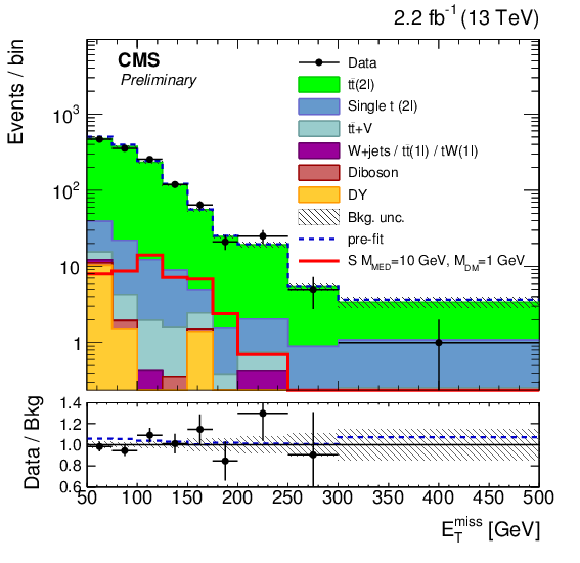
png pdf |
Figure 2-a:
Background-only post-fit $ {E_{\mathrm {T}}^{\text {miss}}} $ distribution for the $\mathrm{ee}$ channel, with the pre-fit SM background, and scalar $M_{\text{MED}}= $ 10 GeV, $M_{\text{DM}}= $ 1 GeV signal overlaid. The last bin includes overflow. The uncertainty band describes the post-fit uncertainty on the total SM background. |

png pdf |
Figure 2-b:
Background-only post-fit $ {E_{\mathrm {T}}^{\text {miss}}} $ distribution for the $\mathrm{e}\mu$ channel, with the pre-fit SM background, and scalar $M_{\text{MED}}= $ 10 GeV, $M_{\text{DM}}= $ 1 GeV signal overlaid. The last bin includes overflow. The uncertainty band describes the post-fit uncertainty on the total SM background. |

png pdf |
Figure 2-c:
Background-only post-fit $ {E_{\mathrm {T}}^{\text {miss}}} $ distribution for the $\mu\mu$ channel, with the pre-fit SM background, and scalar $M_{\text{MED}}= $ 10 GeV, $M_{\text{DM}}= $ 1 GeV signal overlaid. The last bin includes overflow. The uncertainty band describes the post-fit uncertainty on the total SM background. |
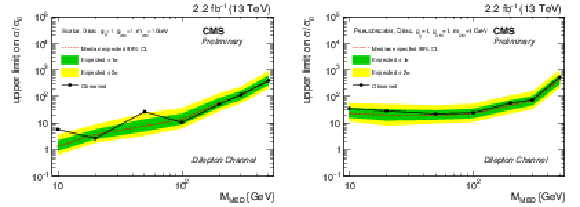
png pdf |
Figure 3:
The observed and expected limits, expressed as the ratio of the 95% C.L. upper limit on DM production cross section to the cross section from simplified model expectations for scalar and pseudoscalar models with a dark matter mass of 1 GeV and $g_q = g_{\text{DM}} =$ 1. |
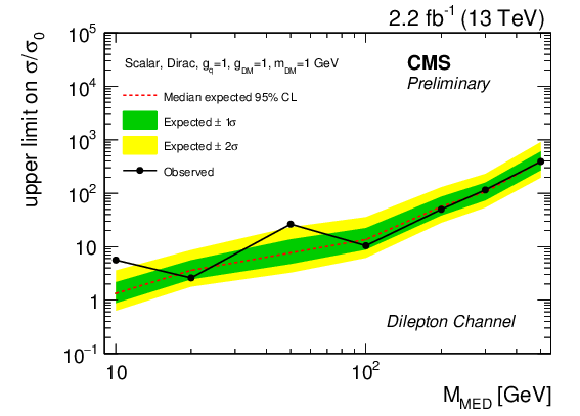
png pdf |
Figure 3-a:
The observed and expected limits, expressed as the ratio of the 95% C.L. upper limit on DM production cross section to the cross section from simplified model expectations for the scalar model with a dark matter mass of 1 GeV and $g_q = g_{\text{DM}} =$ 1. |
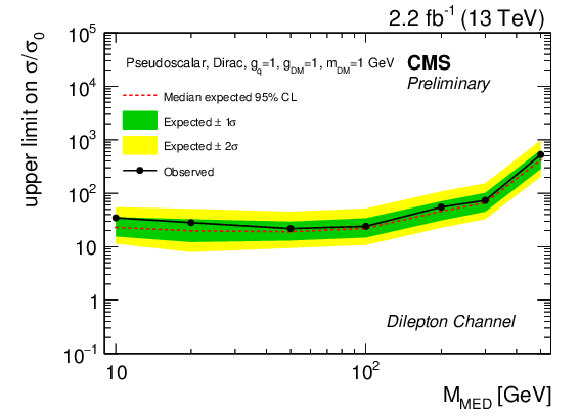
png pdf |
Figure 3-b:
The observed and expected limits, expressed as the ratio of the 95% C.L. upper limit on DM production cross section to the cross section from simplified model expectations for the pseudoscalar model with a dark matter mass of 1 GeV and $g_q = g_{\text{DM}} =$ 1. |
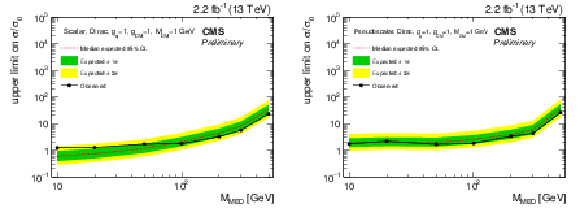
png pdf |
Figure 4:
The observed and expected limits, expressed as the ratio of the 95% C.L. upper limit on DM production cross section to the cross section from simplified model expectations for scalar and pseudoscalar models in the combination of dileptonic, semileptonic, and hadronic channels. |

png pdf |
Figure 4-a:
The observed and expected limits, expressed as the ratio of the 95% C.L. upper limit on DM production cross section to the cross section from simplified model expectations for the scalar model in the combination of dileptonic, semileptonic, and hadronic channels. |
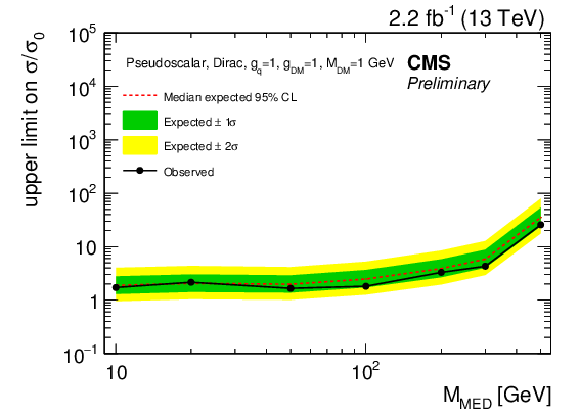
png pdf |
Figure 4-b:
The observed and expected limits, expressed as the ratio of the 95% C.L. upper limit on DM production cross section to the cross section from simplified model expectations for the pseudoscalar model in the combination of dileptonic, semileptonic, and hadronic channels. |
| Tables | |

png pdf |
Table 1:
Background-only post-fit yields and uncertainties. The pre-fit yields for the scalar $M_{\text{MED}}= $ 10 GeV, $M_{\text{DM}}= $ 1 GeV signal and SM expected backgrounds are listed with statistical uncertainties only. |

png pdf |
Table 2:
The observed and expected limits, expressed as the ratio of the 95% C.L. upper limit on DM production cross section to the cross section from simplified model expectations for scalar (S) and pseudoscalar (PS) models from the search in the dilepton channel. |

png pdf |
Table 3:
Listing of systematic uncertainties shown as a percentage of the expected yields for the dominant backgrounds in each channel. The normalisation uncertainties in the dilepton channel apply to the SM $\mathrm{ t \bar{t} }$($2\ell $) process and fall within the uncertainty ranges listed in Sec. {sec:syst}. The exceptions are $R_{\text {in/out}}$ and fakes normalisation which only impact the DY and fakes processes respectively, in the dilepton channel. The uncertainties listed for the $R_{\text {in/out}}$ and Fakes normalisation systematics are per dilepton channel. The uncertainties listed in the ``Semileptonic'' and ``Hadronic'' columns are described in ref [16] and apply to the dominant backgrounds in the respective channels. A ``-'' denotes that the systematic source is not applicable. The shape systematics are illustrative of the magnitude of the uncertainty relative to the expected yield. Sources common across channels are correlated in the channel combination fit with the exception of the lepton efficiency. The lepton efficiency and lepton trigger efficiency are inclusive in lepton flavour for the semileptonic and hadronic channels, however each systematic is split per flavour in the dilepton channel, and thus they are not correlated between the dilepton channel and the others. Uncertainties listed as ranges are across various control/signal regions in each channel. |
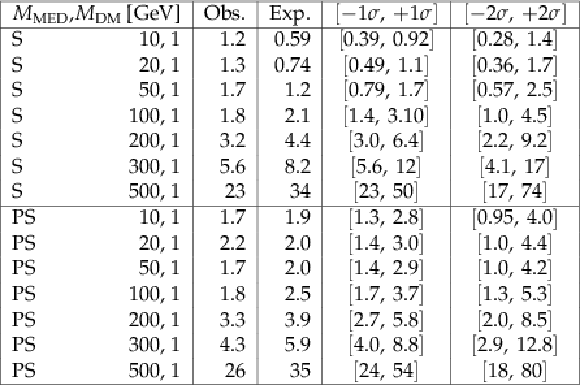
png pdf |
Table 4:
The observed and expected limits, expressed as the ratio of the 95% C.L. upper limit on DM production cross section to the cross section from simplified model expectations for scalar (S) and pseudoscalar (PS) models in the combination of dileptonic, semileptonic, and hadronic channels. |
| Summary |
| A search for dark matter produced in association with top quark pairs decaying to dileptons has been presented. The data sample corresponds to proton-proton collisions at $\sqrt{s}= $ 13 TeV and integrated luminosity of 2.2 fb$^{-1}$ collected by the CMS detector at the LHC during 2015. No significant deviation from SM background expectation is observed in the $E_{\mathrm{T}}^{\text{miss}}$ spectrum for the three dilepton channels ($\mathrm{ee}$, $\mathrm{e}\mu$, $\mu\mu$). A combination with recent results in the semileptonic and hadronic channels is performed. The combination analysis obtains an expected exclusion of scalar mediators with masses up to 39 GeV at 95% CL, with the assumption of Dirac DM particles with $M_{\textrm{DM}}= $ 1 GeV and $g_q=g_{\mathrm{DM}}= $ 1. The observed limits at 95% C.L. fall just short of excluding any range of mediator masses. |
| References | ||||
| 1 | G. D'Ambrosio, G. F. Giudice, G. Isidori, and A. Strumia | Minimal flavor violation: An Effective field theory approach | NPB 645 (2002) 155--187 | hep-ph/0207036 |
| 2 | G. Isidori and D. M. Straub | Minimal Flavour Violation and Beyond | EPJC 72 (2012) 2103 | 1202.0464 |
| 3 | U. Haisch, F. Kahlhoefer, and J. Unwin | The impact of heavy-quark loops on LHC dark matter searches | JHEP 07 (2013) 125 | 1208.4605 |
| 4 | T. Lin, E. W. K. Kolb, and L.-T. Wang | Probing dark matter couplings to top and bottom at the LHC | PRD 88 (2013) 063510 | |
| 5 | M. R. Buckley, D. Feld, and D. Gonsalves | Scalar simplified models for dark matter | PRD 91 (Jan, 2015) 015017 | |
| 6 | U. Haisch and E. Re | Simplified dark matter-top quark interactions at the LHC | Technical Report PH-TH-2015-201, CERN | |
| 7 | C. Arina et al. | A comprehensive approach to dark matter studies: exploration of simplified top-philic models | 1605.09242 | |
| 8 | CMS Collaboration | Search for the Production of Dark Matter in Association with Top Quark Pairs in the Di-lepton Final State in pp collisions at $ \sqrt{s} =$ 8 TeV | CMS PAS B2G-13-004, CERN | |
| 9 | G. Busoni et al. | On the Validity of the Effective Field Theory for Dark Matter Searches at the LHC | PLB 728C (2014) 412--421 | |
| 10 | O. Buchmueller, M. J. Dolan, and C. McCabe | Beyond Effective Field Theory for Dark Matter Searches at the LHC | JHEP 1401 (2014) 025 | 1308.6799 |
| 11 | J. Goodman et al. | Constraints on Dark Matter from Colliders | PRD82 (2010) 116010 | 1008.1783 |
| 12 | M. Beltran et al. | Maverick dark matter at colliders | JHEP 09 (2010) 037 | 1002.4137 |
| 13 | CMS Collaboration | Search for the production of dark matter in association with top-quark pairs in the single-lepton final state in proton-proton collisions at $ \sqrt{s} =$ 8 TeV | JHEP 06 (2015) 121 | CMS-B2G-14-004 1504.03198 |
| 14 | ATLAS Collaboration | Search for dark matter in events with heavy quarks and missing transverse momentum in $ pp $ collisions with the ATLAS detector | The European Physical Journal C 75 (2015), no. 2, 1--22 | |
| 15 | D. Abercrombie et al. | Dark Matter Benchmark Models for Early LHC Run-2 Searches: Report of the ATLAS/CMS Dark Matter Forum | 1507.00966 | |
| 16 | CMS Collaboration | Search for dark matter in association with a top quark pair at $ \sqrt{s} =$ 13 TeV | CMS PAS EXO-16-005, CERN | |
| 17 | CMS Collaboration | The CMS experiment at the CERN LHC | JINST 3 (2008)S08004 | |
| 18 | CMS Collaboration | Particle-Flow Event Reconstruction in CMS and Performance for Jets, Taus, and MET | Technical Report CMS-PAS-PFT-09-001, CERN, 2009. Geneva, Apr | |
| 19 | M. Cacciari, G. P. Salam, and G. Soyez | The anti-$ k_t $ jet clustering algorithm | JHEP 04 (2008) 063 | 0802.1189 |
| 20 | M. Cacciari, G. P. Salam, and G. Soyez | The Catchment Area of Jets | JHEP 04 (2008) 005 | 0802.1188 |
| 21 | CMS Collaboration | Identification of b quark jets at the CMS Experiment in the LHC Run 2 | CMS-PAS-BTV-15-001 | CMS-PAS-BTV-15-001 |
| 22 | J. Alwall et al. | The automated computation of tree-level and next-to-leading order differential cross sections, and their matching to parton shower simulations | JHEP 07 (2014) 079 | 1405.0301 |
| 23 | P. Harris, V. V. Khoze, M. Spannowsky, and C. Williams | Constraining dark sectors at colliders: Beyond the effective theory approach | PRD 91 (Mar, 2015) 055009 | |
| 24 | C. Oleari | The POWHEG BOX | Nuclear Physics B Proceedings Supplements 205 (August, 2010) 36 | 1007.3893 |
| 25 | T. Sjostrand, S. Mrenna, and P. Skands | PYTHIA 6.4 physics and manual | JHEP 05 (2006) 026 | hep-ph/0603175 |
| 26 | R. Frederix and S. Frixione | Merging meets matching in MC@NLO | JHEP 12 (2012) 061 | 1209.6215 |
| 27 | M. L. Mangano, M. Moretti, F. Piccinini, and M. Treccani | Matching matrix elements and shower evolution for top-quark production in hadronic collisions | JHEP 0701 (2007) 013 | hep-ph/0611129 |
| 28 | NNPDF Collaboration | Parton distributions for the LHC Run II | JHEP 04 (2015) 040 | 1410.8849 |
| 29 | S. Agostinelli, J. Allison, K. Amako et al. | Geant4 - a simulation toolkit | NIM A 506 (2003) 250 | |
| 30 | CMS Collaboration | Jet energy scale and resolution performances with 13TeV data | CDS | |
| 31 | CMS Collaboration | Electron and Photon performance using data collected by CMS at $ \sqrt{s} = $ 13 TeV and 25 ns | CDS | |
| 32 | CMS Collaboration | Muon Reconstruction and Identification Improvements for Run-2 and First Results with 2015 Run Data | CDS | |
| 33 | CMS Collaboration | First Muon Identification Efficiencies with 13 TeV, 50 ns Data | CDS | |
| 34 | CMS Collaboration | CMS Luminosity Measurement for the 2015 Data Taking Period | CMS-PAS-LUM-15-001 | CMS-PAS-LUM-15-001 |
| 35 | The ATLAS Collaboration, The CMS Collaboration, The LHC Higgs Combination Group Collaboration | Procedure for the LHC Higgs boson search combination in Summer 2011 | CMS-NOTE-2011-005 | |
| 36 | A. L. Read | Presentation of search results: the CLs technique | Journal of Physics G: Nuclear and Particle Physics 28 (2002), no. 10 | |
| 37 | G. Cowan, K. Cranmer, E. Gross, and O. Vitells | Asymptotic formulae for likelihood-based tests of new physics | EPJC 71 (2011) 1554 | 1007.1727 |

|
Compact Muon Solenoid LHC, CERN |

|

|

|

|

|

|